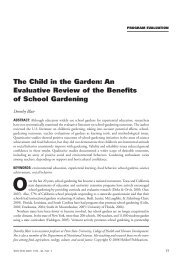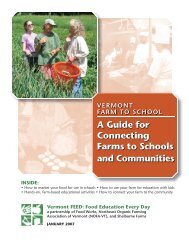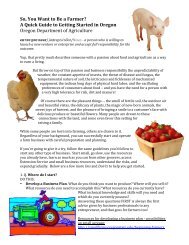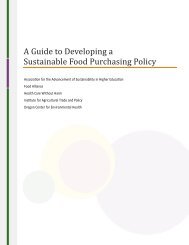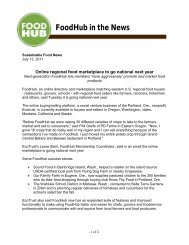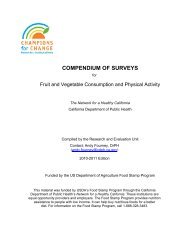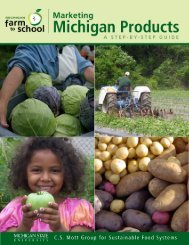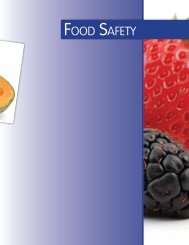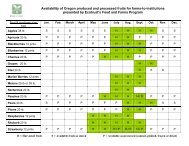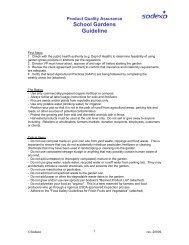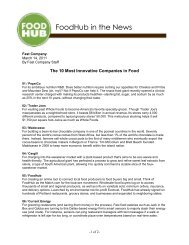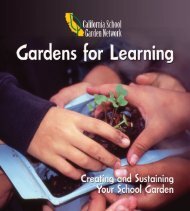eval report cover.indd - New Jersey Farm to School Network Wiki
eval report cover.indd - New Jersey Farm to School Network Wiki
eval report cover.indd - New Jersey Farm to School Network Wiki
You also want an ePaper? Increase the reach of your titles
YUMPU automatically turns print PDFs into web optimized ePapers that Google loves.
CLP-CA: DAVIS JOINT UNIFIED SCHOOL DISTRICT,CALIFORNIA – THE “CRUNCH LUNCH” PROGRAMDavis Joint Unified<strong>School</strong> District, CAFree / reduced mealeligibility: 15.9%Total schools: 16Enrollment: 8537Demographics:64.7% White, 14.2%Asian, 13.6% HispanicLocal product used in:Salad bars / prepackaged saladsOther program components:In-class nutrition education,school gardens, wastemanagement and recyclingprogram, farm <strong>to</strong>urs,farmer in the classroomof the farm <strong>to</strong>school salad bar program. However, with expansionof sites came increases in labor and equipmentcosts that were prohibitive. To cut down overalllabor costs for the food service operations, a stateof the art central kitchen was established, which hasthe capacity <strong>to</strong> package more salads per day. Th e inaugurationof the central kitchen meant the end ofthe self-service salad bar. The packaged salads alsoused some local produce.DJUSD’s farm <strong>to</strong> school program, one of the fewin the country that has been studied extensively, isthe only one <strong>eval</strong>uated on a longitudinal basis from2000 <strong>to</strong> 2006. Unfortunately, the cafeteria model forserving local product in DJUSD schools changedsubstantially over the six years for which data wasavailable, making it difficult <strong>to</strong> make comparisons,without taking in<strong>to</strong> account all the related fac<strong>to</strong>rs.Th e data gathered, however does provide a strongbase for understanding six years of a farm <strong>to</strong> schoolprogram, its impacts, and the reasons behind thechanges that occurred at the district.Feenstra Gail and Ohmart Jeri, UC Sustainable AgricultureResearch & Education Program, Yolo County <strong>Farm</strong> <strong>to</strong> <strong>School</strong>Evaluation Report 2005.Feenstra Gail and Ohmart Jeri, UC Sustainable AgricultureResearch & Education Program, Yolo County <strong>Farm</strong> <strong>to</strong> <strong>School</strong>Evaluation Report Year 4 Annual Report Fall/Winter 2005-06.Feenstra Gail and Ohmart Jeri. Yolo County <strong>Farm</strong> <strong>to</strong> <strong>School</strong>Evaluation Report for the California <strong>Farm</strong> <strong>to</strong> <strong>School</strong> Program,Center for Food & Justice, Occidental College. Oc<strong>to</strong>ber 2004.Davis Joint Unifi e d <strong>School</strong> District’s farm <strong>to</strong>school program was started in 2000. Throughits years of operation, the program had strongsupport in the community through the Davis <strong>Farm</strong> <strong>to</strong><strong>School</strong> Connection, a project of the Davis EducationalFoundation whose members participated in the planning,implementation and marketing of the project, aswell as supporting the food service as needed. Several ofthe members on this committee were parents who joinedothers in volunteering at the school district <strong>to</strong> supportthe educational activities, gardens and recycling programs.A brief his<strong>to</strong>ry of how the program progressedis outlined below.A key driver for the changes in the salad bar model wasthe attempt <strong>to</strong> attain financial viability. Initially, it wasthought that increasing the number of schools, andtherefore the volume of local product served, would evenout the costs2000-01 One elementary school operatinga salad bar; studentsoffered choice between saladbar and hot entrée everyday2001-02 Th ree elementary schoolsoperating salad bar; studentsoffered choice between saladbar and hot entrée everyday2002-03 Five elementary schools,only salad bar offered as themeal everyday, includingprotein, bread and milk andadhering <strong>to</strong> USDA requirementsfor a fully reimbursablemeal. Growth <strong>to</strong> sevenelementary schools, onlysalad bar offered as the mealeveryday, including protein,bread and milk and adhering<strong>to</strong> USDA requirements for afully reimbursable meal2003-04 All eight elementary schoolsoperational with samemodel as above2004-05 All eight elementary schools,change <strong>to</strong> salad bar offeredon two days a week withchoice of hot entrée2005-06 Pre-packaged salads offereddaily <strong>to</strong> all eight elementaryschools, along with hot entréewww.farm<strong>to</strong>school.org 65Conclusions <strong>Farm</strong> <strong>to</strong> <strong>School</strong> and Program RecommendationsProfiles



